Herb garden design
formal or 'natural' layout ?
dedicated to my sister in greenness
Herb garden design through history: the rise of the formal herb garden layout, and alternatives
Herb garden design is steeped in tradition and some history is very appropriate. An overview allows us to either choose to imitate history, imitate nature, or do something else entirely.
In the last section of this article I will present three very simple tricks for laying out a 'natural' wilderness like herb garden and getting away from the strict gridlines of tradition without getting 'lost' in the detail.
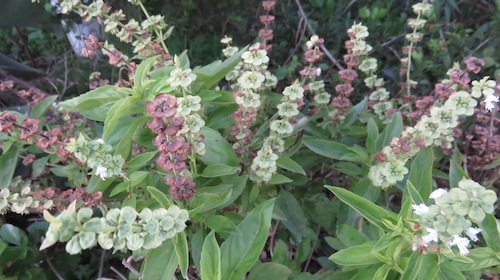
The history of herb garden design in the west
Much of the history one finds is European, and I wish there were more information on historic medicinal gardens from all regions of the world, because herbalism was ubiquitous throughout the world before pharmaceuticals took over, and every region has a tradition of herbal medicine, and a slightly different assemblage of plants, which give the gardens their own unique character, and different usages which must be at least as interesting as regional cuisine.
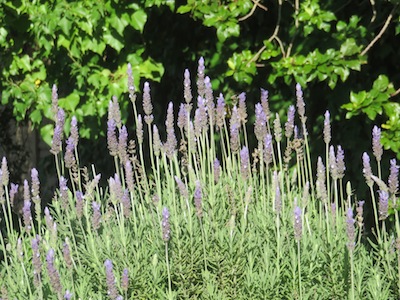 lavender a classic in herb garden design can serve as a hedge
lavender a classic in herb garden design can serve as a hedgeThe old English country herb garden of the early middle ages was informal and close to hand, at the door, and they were called dooryard gardens. All things were planted together higgeldy piddeldy. Separating flowers and herbs and vegetables is a more recent innovation. In medieval Europe all plants were assumed to have medicinal value anyway.
In the Renaissance the fields of botany, medicine and horticulture began to diverge. Medieval and Rennaissance monastry gardens were formal but very functional because the beds were like a medicine cabinet's drawers. In the example given by the Brooklyn Botanic Garden, a plan for a medicinal garden at the monastry of St Gall, south of lake Konstanz in Switzerland, the medicinal herbs were grown in raised rectangular box shaped beds, one species to a box, and arranged in two straight parallel rows and the whole garden was enclosed with brick walls, probably to preserve the heat of the mild northern sun.
The tradition of inclosure may have another origin in the Persian 'paradise' garden. The name is derived from the Persian pairi (around) diz (wall). This garden layout goes back to the Achaemenid Empire (550-330 B.C.), with a culture that influenced the Athenians, among others. The walled garden with paths forming a cross quartering the garden and a well at the centre, became overlaid with Koranic and Biblical symbolism as the idea of gardening just for beauty spread out from from Persia. It is one of the basic garden styles which has influenced the most gardens of the world.
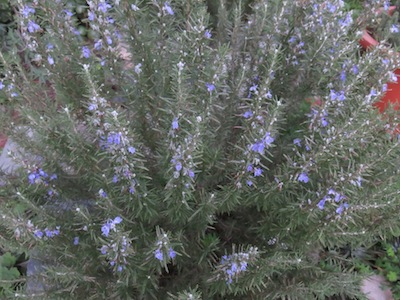 rosemary, a Mediterranean native for herb garden design
rosemary, a Mediterranean native for herb garden designIn the thirteenth century, private pleasure gardens emerged in Europe and might include an herb garden called an herber. These could be quite ornamental with a small lawn at the centre surrounded by beds of sweet smelling herbs
Next the botanical gardens developed on the same utilitarian pattern as the monastry gardens, for teaching medical students about medicinal herbs. This is not surprising as the old universities were run by monks, and there are essentially similar formal herb garden layout patterns right up to the 17th Century in medicinal gardens. Enclosure of herb and kitchen gardens with brick or stone walls or wattle fencing was the norm, partly to keep out animals, probably also as wind protection, and warmth preservation. Herb garden design in the west is a very conservative slow moving tradition.
At about this time the Europeans began to travel the world in their ships and collector’s gardens arose housing plants brought back from all regions of the world.
The first paradise gardens in ancient times were planted with fruit and flowering trees but the Islamic gardens of the world became more and more formal, with beautiful symbolic geometry, which doubtless also is the origin of the knot garden and parre terre style, and untold generations of formal herb garden design.
In the Renaissance the knot garden also became fashionable in Europe. The tradition of clipped hedges boxing in the herbs took on more complex forms. These hedge plantings were drawn out on the ground and planted with single species for neatness and uniformity. The spaces between hedges could be filled with coloured gravel. I would call this type of garden a parterre. It is designed to be viewed from upper story windows more than the ground. Lavender, Germander and Santolina were used for hedges in Elizabethan gardens. Box became popular in the 17th Century.
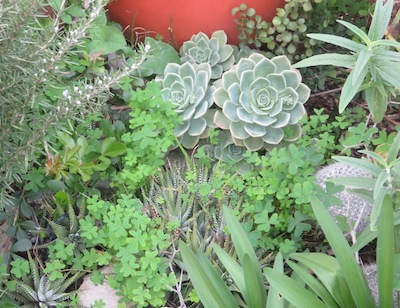 a very divergent and partly self seeded mix
a very divergent and partly self seeded mixAfter this, in the 18th and 19th Century the functions seen in herb garden design became more mixed again, combining utilitarian, food and decorative plants. A few centuries of exotic plant collection had ensued, which became very competitive and led to the construction of expensive green houses or conservatories on private Estates as massively expensive status symbols of horticultural display. This collection of exotic plants peaked with the Victorians, and then a reaction occurred with a return to tradition and a trend towards the old classic country garden plants of England. The planting of specialized ‘herb gardens’ in the old Renaissance mode was accompanied by a revived interest in medicinal herbs.
In the 1940’s Vita Sackville West, one of the most famous ‘modern’ British gardeners created the Sissinghurst herb garden, which though referencing historic gardening in its quartered layout, laid a new emphasis on ornamental elements like plant colour and shape.
In the last twenty years there has been increased interest and creative latitude in herb garden design, and the distinction between herb, food and ornamental garden becomes fluid again.
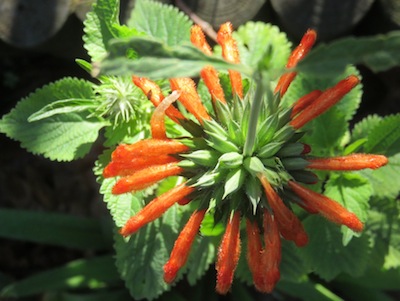 a beautiful African medicinal: Leonotus leonorus
a beautiful African medicinal: Leonotus leonorusThis has only been the story of herb gardens of the United States and England. These would have been influenced by herb gardening from mainland Europe in the monasteries and palace gardens of France and Italy. The plants were often exotic at first, coming from the eastern Mediterranean, from areas such as Anatolia, via the ancient networks of monasteries. Most of the well known culinary herbs come from warmer parts of the world. But what of Asia, Africa and the Americas ? I have put together some ideas which are of necessity patchy as the field is much less documented and researched.
African herb gardens
African plants and gardens are inspirational models for the herb garden designer. A search on Kenya produced a fantastic formal herb garden amidst ancient stone walls at the Nairobi national museum, and there are pictures of large medicinal herbs and food plants, which would be a great addition to any mixed planting of useful herbs. Herb garden styling could also be modeled on the beautiful small farm gardens of Kenya, with fields edged with rows of rushes.
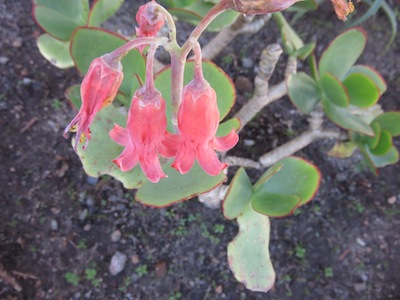 another widespread medicinal plant in this region: Cotyledon
another widespread medicinal plant in this region: CotyledonGoing deep into our history for another idea, a formal herb garden could also be laid out in the ancient Egyptian style with linear paths and ponds, papyrus, oleander, rosemary and cyprus. For plants to build a medicinal garden there is an interesting site called Botanic Ethiopica about the conservation of medicinal herb diversity. Artemisia abyssinica or Chikugn, Artemisia afra, Ginger, Withania somnifera, Aloe vera, fennel and Verbena are some familiar herbs used in herbal medicine with indigenous Ethiopian appelation, and then there are some other less familiar herbs like Ocimum lamifolium or Demakese, Echinops kebericho or Kebercho. South Africa has an incredible wealth of herbs and medicinal plants due to the species diversity of the Fynbos. The trade in herbal medicine is a multi million industry and its roots go back thousands of years to the first peoples of South Africa, who were the greatest custodians of medicinal knowledge, and perhaps even further, because people have been living here and using these plants for hundreds of thousands of years. In effect our National Botanic Gardens are herb gardens, there are so many useful plants.
The natural vegetation forms ‘cushions’ or close to the sea, tables clipped by the wind, and these forms fit perfectly with a Mediterranean herb garden design. The forests also contain medicinal trees, and any herb garden can include some of these in a medicinal ‘forest’ section with ferns and mossy boulders, as there are medicinal trees from all regions.
A herb garden with tropical herbs can even look like a 'jungle garden' with palms, ferns, lianas, enormous dramatic leaves and strange gorgeous flowers. The tropical rain forests are also species rich and full of wonderful plants such as many of the meso-American Hawaiian and west African edibles and the spice plants of the far east.
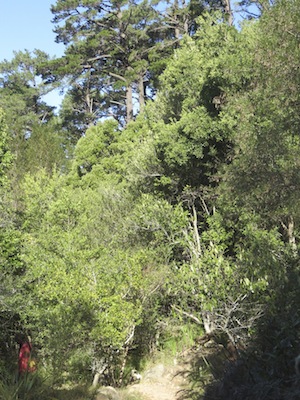 this too is a herb garden: of medicinal trees
this too is a herb garden: of medicinal treesAsian herb gardens
Asia has some large public herb gardens, like the mix of traditional Japanese gardening aesthetics and European herb garden formality seen at the vast Nanobuki herb garden at Kobe with its Tudor style cable station. Then there is the Hiruzen herb garden at the community gardens in Okayama, where lavender and 200 other perfumed herbs are grown surrounded by vast Hydrangea and conifer gardens. On a more scientific note there is the Takeda Garden for Medicinal Plant Conservation in Kyoto, which houses medicinal plants from all around the world. Then there is the Tokyo Metropolitan Medicinal Garden. There are seven public medicinal gardens in the Kanto region alone. A group of Japanese landscape designers have created the Earthscape project to raise awareness of healing herbs. They travel from place to place building giant 60 meter herb gardens in the shape of a man. The Kirstenbosch useful plants garden is just a nod to our rich herbalism tradition by comparison.
Indian herb gardens online have numerous sites relating to Ayurvedic medicine in India, these often involve informal forest like plantings. On the formal side there is an amazingly bold ornamental herb garden design in the Red Fort at Agra, and many other breathtaking formal gardens, such as the Mughal gardens, which include herbs, vegetables and flowers. The Indian royal gardens were one of the great models for the west during the European Renaissance. There are many iconic Indian gardens with world heritage status in garden design.
China also has its own very strong herbal medicine tradition, and beautiful gardening tradition. Herbs are grown mostly on farm plots as there is a massive market for herbal medicine. Herb gardens for display seems more prevalent in the Chinese medicine gardens in California.
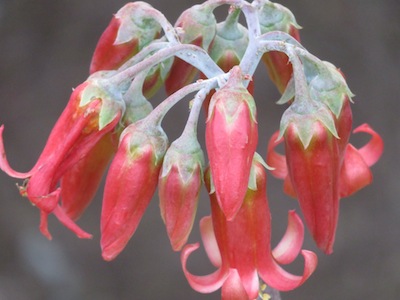
Herb gardens of the Americas
There are several Chinese medicinal herb gardens in the United States such as the one at UC botanic garden, built with Chinese and American cooperation.
Mexico has a wealth of culinary, medicinal and food plants used since the time of the Maya and Aztecs, which form part of the superb and diverse cuisine of Mexico. Without meso and south America agriculture, the food culture of the world would look very different today, with no tomatoes, maize, potatoes and chilis, for starters, but there are also many herbs and spices native to Meso America. The agriculture of ancient times involved aquaculture and a form of mixed forest creation, that the permaculture of today would call a food forest. A low stone wall would contain a mixed grove of trees, lianas and herbs which could include spice plants, medicines and food crops. These could be harvested regularly but were at a distance from home. Close to home were kitchen gardens with multi purpose Agave and probably beans, maize and flowering plants. Floating gardens in the lakes must have been something to behold. I imagine tomatoes would have done very well in these gardens, because they thrive in aquaponics. Last on our very brief search for herb garden design ideas from around the world, in Brazil, experimentation with food marketing has led to supermarkets which sell food and herbs straight from a specially constructed garden where the ‘shelves’ are banks of growing plants. Herbs also can form the basis of a vertical garden. These both involve a highly constructed form of containment for growing plants working with various materials from non rotting fabrics, to wood and plastic.
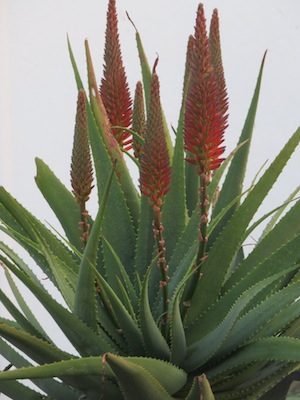 in herb garden design large succulents add drama to the medicinal garden
in herb garden design large succulents add drama to the medicinal gardenConserving water in your herb garden design
If your garden is on sloping ground, you can terrace or use swales. The ancients from all around the world used stone terracing to conserve water and prevent erosion. Such terraces are attractive, ecologically sound and provide wonderful microclimates to diversify your garden. You can but plants which love good drainage on top of the walls, and those which like a damp cool root run at the bottom of the walls. Terraces are a feature of historic African, Mediterranean, South American and Asian agriculture. Swales are permaculture’s version of the horizontal water trapping element, and are geared to establishing forest along horizontal bands.
I hope this and the picture album I’ve collected, give a taste of the amazing possibilities in designing a herb garden. If one thinks out of the box, the herb garden design does not have to be influenced by medieval European tradition ! I’ve mentioned the gardens of the monks because the Benedictines brought grafting, vines and so many things gardeners take fore granted from the Middle East to Europe, and their history is interesting, but I prefer a herb garden that is a little wild.
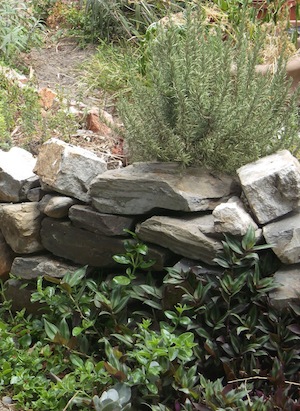 rosemary loves being on top of a dry stone terrace !
rosemary loves being on top of a dry stone terrace !How to make a garden look wild !
Herbs are the ideal plants for turning your cabbage patch into a natural wild looking garden. Not only do they bring the beneficial associations of companion planting, and attracting pollinators, but they add different sculptural notes, fine umbels, grey needled foliage, colourful berries, perfumes and more. Herb garden design has so much potential for following nature. In our region where the desire for lushness poses an ecological threat and we have to get used to the aesthetic of arid looking gardens, herbs contribute to creating the appearance of Mediterranean vegetation, which looks more natural in this region, or in desert gardens, and they harmonize with local medicinals like Agathosma sp. or Buchu, and culinary herbs like Oxalis sp. and Eriocephalis africanus. Our own Rhus, Agathosma and Salvias also make lovely clipped hedges if you want formality, and of course aloes and other succulents can be the crowning glory and centerpiece of an arid climate African medicinal herb garden.
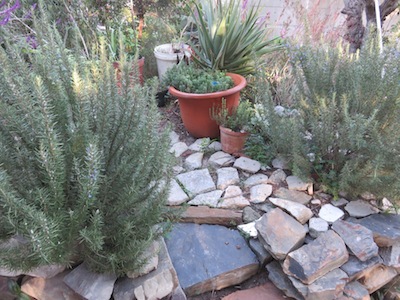 Mediterranean herbs and succulents mix well visually
Mediterranean herbs and succulents mix well visuallya 'wild' herb garden design
3 easy systems that gives you freedom
1 using a linear grid
for natural herb garden design
The formal herb garden is based on containment, either in pots, or boxes, or frames of wicker, or clipped hedges. The strict geometry of the container gives it its 'formal' appearance, gives it geometry.
In the natural looking herb garden there can also be a strict geometry, but it lies in the planting 'grid'. It consists in overlaying the different spacing distances of various plants. If you were to draw a spacing plan, looking like a strictly laid out lettuce bed for example, and overlay that with a grid for something smaller, like wheat, at a slight angle, you would get lettuce scattered amongst the wheat. Overlay this with a grid for planting something really huge and dramatic like artichokes or broccoli, where the distances are greater and you will get broccoli scattered thinly among the lettuce and wheat. If you overlay this with patterns for spacing some other plants, always putting the grid at a different angle, you will begin to get a random natural appearance. This is enhanced if you place the larger dense fine clumps first, then place the largest plants on the largest grid, leaving a gap if there is already a dense clump on the spot, then the next largest, leaving a gap if the spot is already taken, and so forth.
The spacing grid should not be as tight as it is when a bed is a monoculture, because you are going to interplant many different plants.
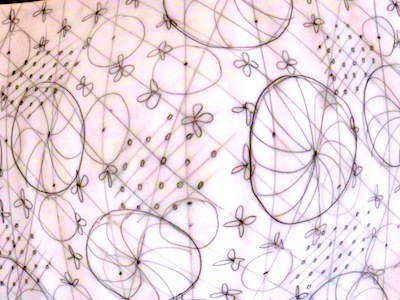 a natural looking spacing for herb garden design, overlay multiple straight line grids on different scales and angles
a natural looking spacing for herb garden design, overlay multiple straight line grids on different scales and angles2 using organic spacing
in herb garden design
To get an even more natural effect there should not be a straight grid with straight rows either of course. Space plants equal distances apart, but organically, avoiding straight lines. I have done a mockup of the this type of planting below using layers of tracing paper.
I hope the sketch makes my idea clear. This is the way things grow in the wild. As with the regular organic spacing of animals in the intertidal zone, there is a battle for room, its all about spacing the optimum number of plants in the smallest area, each avoiding competition with the other, unless they are plants that like to grow in dense stands. For these very closely planted herbs like a grass, make the stands well spaced and isolated from each other otherwise there will be no space for anything else.
I've arbitrarily chosen my plants here, just to illustrate the overlaid grid principle. You can choose anything of course. The last grid will probably have empty spaces, which you can fill according to your choice with broadcast flower seeds or anything you wish. I'm using mustard in the big spaces in the grid as the filler, I love its fresh luscious greens and tall spindly flower heads, and I'll broadcast Californian poppies over the rest of the space.
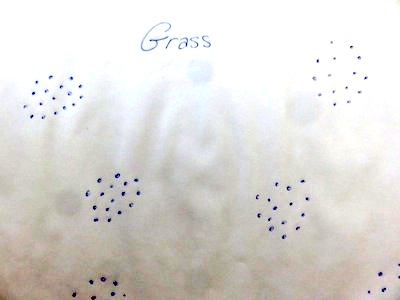 dense isolated clumps
dense isolated clumps large sculptural artichoke can be interspersed with tall grassy herbs as seen in the plan below
large sculptural artichoke can be interspersed with tall grassy herbs as seen in the plan below overlay multiple organicaly spaced grids for natural looking random spacing
overlay multiple organicaly spaced grids for natural looking random spacingPlot the frequency (that is the closeness) of a particular plant on your grid according to the frequency of your use of that plant, and make it larger than the ideal spacing in monoculture, as said.
Also incorporate some foliage shape, colour and plant form variation but be careful to overdo the variation. Let there be harmony with a tiny percentage of contrast, rather than everything being at war with the next visually. In design terms, harmony can mean not identical but similar colour and or leaf shape, and contrast would be something diametrically opposite to this, such as combining low round leafy vegetation of various plants, with the occasional tall feathery one, perhaps even with flower heads. Overdone colour variation with each plant a different colour is in the mode of ghastly garden design that is still common and very commercial. For example beds of different conifers, with yellow green and grey foliage, and then some red too, usually prunus, can look like amateurish overkill by someone who fastened on the design rule "foliage variation". Diversity in leaf shape and plant form tends to sit more kindly than excessive diversity in colour. Observe a piece of nature you find beautiful. Look carefully at its plant frequencies and what grows in stands and how much the forms and colours vary and how.
3 random patterning for the most natural plant spacing
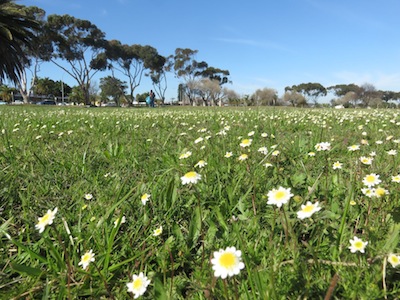
To create much more random patterning you can throw some white pebbles on the ground and plant where they fall, or splatter drops on your design sheet and overlay several different random scatter patterns like I overlaid the grids.
Each random scatter could be a different one on a different scale, some could be dense and some sparse. Indeed it seems to be what is happening in nature, with a little mediation through competition keeping some plants more evenly far apart and others being more clustered as they spread vegetatively. These photos should give you a good eye for free growing patterns which is a geometry that is found everywhere once you start looking for it.
Random scatter patterns in windblown leaves, and the growth of water plants and flowers
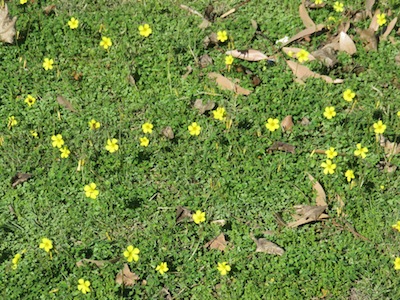  |
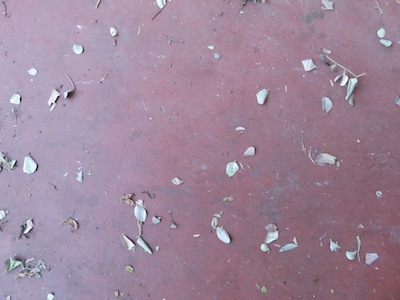 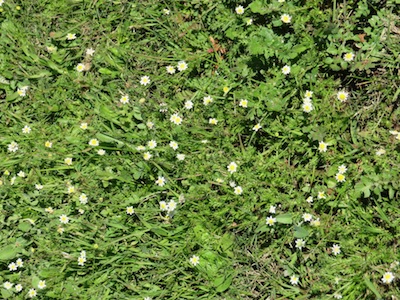 |
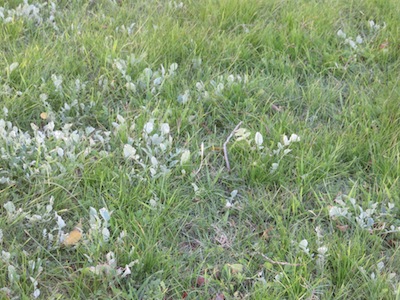 two scales of random patterning based on seed dispersal and space need, enhanced by leaf differences
two scales of random patterning based on seed dispersal and space need, enhanced by leaf differences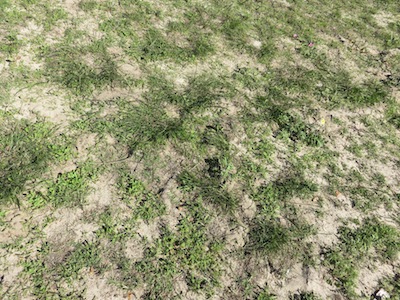 two overlaid scales of random pattern, mediated by competition, making the smaller more evenly spaced
two overlaid scales of random pattern, mediated by competition, making the smaller more evenly spaced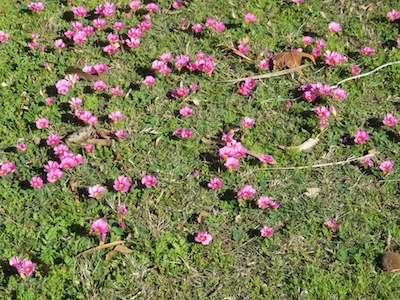 random patterning mediated by the vegetative growth from an underground rhizome, clumping the plants
random patterning mediated by the vegetative growth from an underground rhizome, clumping the plants lichen on a rock in Newland's forest, Table Mountain
lichen on a rock in Newland's forest, Table MountainGo from "Herb garden design to the Sitemap
------
home page for lots of tips on home gardening
------
------
a reference on herb garden design history
-------
herb garden design inspiration from around the world
------
traveling herb man café project
Ask us ?
If you have any questions please let us know !
Restore Nature Newsletter
I've been writing for four years now and I would love to hear from you
Please let me know if you have any questions, comments or stories to share on gardening, permaculture, regenerative agriculture, food forests, natural gardening, do nothing gardening, observations about pests and diseases, foraging, dealing with and using weeds constructively, composting and going offgrid.
SEARCH
Order the Kindle E-book for the SPECIAL PRICE of only
Prices valid till 30.09.2023
Recent Articles
-
Rose
Dec 17, 23 04:08 AM
I am doing research on growing wildlife foraging plants to use in enhancement plantings with wildlife in mind. My thoughts after seeing bears too skinny -
Seeds for a bred Sweeter less acidic Kei apple
Nov 20, 23 03:24 AM
Greetings Greenidiom, I'm a small farmer in kenya. I'm looking to plant a Green fence around a 6 acre plot of land and, I'd wish to make it of kei apples -
Mrs Laura Robinson
Oct 08, 23 02:17 AM
How do I get a copy of the soil aggregation poster??
"How to start a profitable worm business on a shoestring budget
Order a printed copy from "Amazon" at the SPECIAL PRICE of only
or a digital version from the "Kindle" store at the SPECIAL PRICE of only
Prices valid till 30.09.2023






